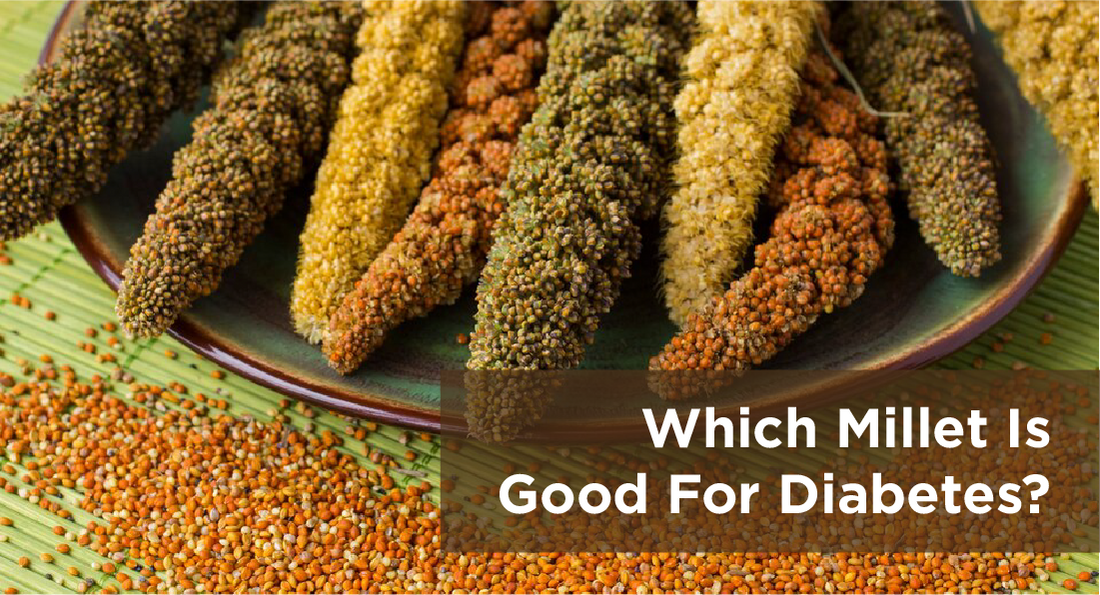Millets are a great source of nutrition and have been around for centuries. They are highly nutritious, low in calories and can help in weight loss, as well as controlling diabetes. Millets are also known to have a low glycemic index, which means they are slowly absorbed and can help raise blood sugar gradually, making them an excellent choice for those with diabetes. There are several types of millets available, such as pearl millet, finger millet, foxtail millet, barnyard millet, and kodo millet, all of which have different nutritional content. Each type of millet has its health benefits, but some are better for managing diabetes than others. In this article, we will discuss which millet is good for diabetes and how it can help control blood sugar levels.
What is a Low-Carb Diet? What are Millets?
Millets are a group of small-seeded grasses widely grown and consumed in many parts of the world. They are gluten-free, high in fibre, and have a low glycemic index, making them an excellent option for people with diabetes. Millets are also rich in essential nutrients such as magnesium, iron, and B vitamins, making them a healthy addition to any diet.
Pearl millet, also known as Bajra.
It is one of the most popular millets widely used in India and other parts of the world. It is a whole grain and is high in fibre, which helps to slow down the digestion and absorption of glucose in the body, thus helping to regulate blood sugar levels. It is also rich in complex carbohydrates, which can help reduce blood sugar spikes after meals. Pearl millet also contains magnesium, which is essential for the proper functioning of the muscles and nerves, and it also has numerous other essential vitamins and minerals.
Finger millet, also known as Ragi.
It is another type of millet that can benefit those with diabetes. It is high in protein and contains essential amino acids, making it a great source of nutrition. Finger millet is also rich in fibre, which helps to slow down the digestion and absorption of glucose, thus helping to control blood sugar levels. It also contains minerals such as iron, calcium, and magnesium, essential for maintaining healthy blood sugar levels.
Foxtail millet, also known as Korra.
It is another type of millet that is beneficial for those with diabetes. It is high in fibre and complex carbohydrates, which help to slow down the digestion and absorption of glucose, thus helping to regulate blood sugar levels. It also contains several essential vitamins and minerals, such as iron, magnesium, and calcium, necessary for maintaining healthy blood sugar levels. Foxtail millet is also high in protein, which can help to reduce blood sugar spikes after meals.
Barnyard millet, also known as Sanwa.
It is a type of millet that can benefit individuals with diabetes. This millet is rich in fibre and complex carbohydrates, which can help regulate blood sugar levels by slowing down the digestion and absorption of glucose. By doing so, it prevents sudden spikes in blood sugar levels.
In addition to its blood sugar-regulating properties, barnyard millet is also a good source of essential vitamins and minerals. It contains iron, magnesium, and calcium, critical for maintaining healthy blood sugar levels. These nutrients play a crucial role in the body's insulin production and utilization, essential for individuals with diabetes.
Another benefit of barnyard millet is its high protein content. Protein helps reduce blood sugar spikes after meals, making it an excellent choice for individuals looking to manage their blood sugar levels. Furthermore, the protein content in barnyard millet can aid in weight loss, which is often recommended for individuals with diabetes to improve their overall health and manage their condition effectively.
Overall, incorporating barnyard millet into a diabetes-friendly diet can provide numerous health benefits. It is a nutritious grain that can help control blood sugar levels, support weight loss efforts, and provide essential vitamins and minerals. However, it is important to consult with a healthcare professional or a registered dietitian before making any significant changes to your diet, especially if you have diabetes or any other medical condition.
Diabetes is a chronic disease that affects millions of people worldwide. It is characterized by high levels of sugar in the blood, which can lead to serious health complications if not managed properly. One way to manage diabetes is through a healthy diet, and incorporating millets into your meals can be beneficial. In this article, we will discuss which millet is good for diabetes and how it can help control blood sugar levels.
Millets and Diabetes

Millets have been shown to have a positive impact on blood sugar levels, making them a good option for people with diabetes. They have a low glycemic index, which means they are digested and absorbed slowly, resulting in a gradual rise in blood sugar levels. This is beneficial for people with diabetes as it helps prevent spikes in blood sugar levels, which can be dangerous.
How to Incorporate Millets into Your Diet
Millets are versatile grains that can be easily incorporated into your diet in various ways. Here are some detailed suggestions on how to include millet in your meals:
1. Millet Porridge:
Millets can be cooked into a creamy and nutritious porridge. Cook the millets with water or milk, add your choice of sweeteners like honey or fruits, and enjoy a warm and filling breakfast.
2. Soups and Stews:
Millets can be added to soups and stews to enhance their nutritional content and add a hearty texture. They can replace other grains like rice or pasta in recipes such as vegetable soup or chicken stew.
3. Rice or Wheat Substitute:
Millets can be a healthy replacement for rice or wheat in various dishes. You can cook millets like pearl or barnyard millet and use them as a base for pilafs, biryanis, or stir-fries. They provide a unique nutty flavour and a satisfying chewiness.
4. Salads:
Millets can be a great addition to salads, adding a crunchy texture and boosting the nutritional value. Cooked millets can be mixed with fresh vegetables, herbs, and dressings to create a delicious and wholesome salad.
5. Millet Flour:
Millet flour is a gluten-free alternative to wheat flour and can be used in various baked goods. You can use millet flour to make bread, pancakes, muffins, cookies, and other treats. It adds a slightly sweet and nutty flavour to your recipes.
6. Snacks and Side Dishes:
Millets can make snacks and side dishes. You can make millet-based cutlets, patties, or fritters by combining cooked millets with vegetables and spices. These can be a healthy alternative to fried snacks.
7. Millet-based Desserts:
Millets can also make delicious and healthy desserts. You can use millet flour to make desserts like millet pudding, halwa, or millet cookies. These desserts are not only tasty but also provide the nutritional benefits of millet.
Remember to experiment with different millet varieties and recipes to find your favourites. Millets are not only beneficial for managing diabetes but also offer a range of health benefits, including weight loss and improved digestion. Introducing millet into your diet can be a simple and effective way to enhance your overall well-being.
There are many ways to incorporate millet into your diet. You can use them to make porridge, add them to soups and stews, or use them as a substitute for rice or wheat in dishes such as pilaffs and salads. You can also find millet flour, which can be used to make bread, pancakes, and other baked goods.
Millets and Diabetes:
Millets have gained popularity as a healthy grain option for individuals with diabetes. They are known for their low glycemic index, which means they cause a slower rise in blood sugar levels compared to other carbohydrates. This makes millet an excellent choice for managing diabetes.
Among the different types of millet, foxtail millet, finger millet, and pearl millet are particularly beneficial for individuals with diabetes. These millets are rich in essential nutrients such as fibre, vitamins, and minerals, which help control blood sugar levels.
The high fibre content in millets aids in regulating blood sugar levels by slowing down the digestion and absorption of carbohydrates. This helps in preventing sudden spikes in blood sugar levels after meals. Additionally, millets promote better insulin sensitivity, which is crucial for individuals with diabetes.
Including millet in your diet can be done in various ways. You can prepare millet porridge by cooking millet with water or milk and adding sweeteners like honey or fruits. Millets can also be added to soups, stews, and salads to enhance their nutritional content. They can even be used as a substitute for rice or wheat in dishes like pilafs and stir-fries.
Millet flour is another great option for individuals with diabetes. It is a gluten-free alternative to wheat flour and can be used in baking bread, pancakes, muffins, and cookies. The slightly sweet and nutty flavour of millet flour adds a unique taste to your recipes.
Incorporating millet into your diet not only helps in managing diabetes but also offers additional health benefits. Millets are known to aid in weight loss due to their high fibre content, which promotes a feeling of fullness and reduces calorie intake. They also improve digestion and support overall well-being.
In conclusion, millets are a valuable addition to the diet of individuals with diabetes. They provide essential nutrients, regulate blood sugar levels, improve insulin sensitivity, and offer a range of health benefits. By including millet in your meals, you can effectively manage your diabetes and enhance your overall health. Why not give millets a try and experience the positive impact they can have on your well-being?
However, the information provided here hopefully helps you understand the benefits of millet for diabetes management.
Conclusion
In conclusion, millets are a great option for people with diabetes. They have a low Glycemic index, are rich in essential nutrients, and have been shown to improve blood sugar control and insulin sensitivity. Foxtail millet, finger millet, and pearl millet are some of the best millet for diabetes. By incorporating millet into your diet, you can improve your overall health and manage your diabetes more effectively.
Have you tried incorporating millet into your diet? Let us know in the comments below!
To get Clinically tested diabetic-friendly food products, click here.
References
- Managing Diabetes Mellitus With Millets: A New Solution - PMC
- Which millets are good for diabetes? - Freedom from Diabetes
- A Review of the Potential Consequences of Pearl Millet (Pennisetum ...
- Effects of dietary protein of Korean foxtail millet on plasma ...
- Dietary Japanese millet protein ameliorates plasma levels of ...
This Blog post is an initiative by DiabeSmart, to provide accurate and Nutritionist / Doctor approved information related to Diabetes. DiabeSmart is India's first Food brand designed specifically for Diabetics, that has been clinically tested on Diabetics and Pre-Diabetics to deliver 55% - 70% lower Sugar spikes. DiabeSmart is part of Lo! Foods - India's leading brand for Everyday Functional Health foods.















